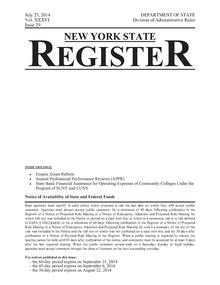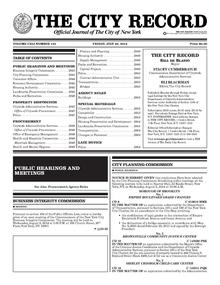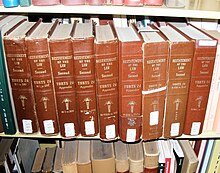Law of New York (state)
 From Wikipedia - Reading time: 14 min
From Wikipedia - Reading time: 14 min

The law of New York consists of several levels, including constitutional, statutory, regulatory and case law, and also includes local laws, ordinances, and regulations. The Consolidated Laws form the general statutory law.
The Constitution of New York is the foremost source of state law. The legislation of the Legislature is published in the official Laws of New York and codified in the Consolidated Laws of New York. State agency rules and regulations are promulgated in the New York State Register and codified in the New York Codes, Rules and Regulations. Because New York is a common law state, every opinion, memorandum, and motion sent by the New York Court of Appeals (New York's highest court) and the Appellate Division of the New York Supreme Court (an intermediate appeals court) is published. Each local government may also adopt local laws, and counties, cities, and towns may promulgate ordinances to the extent authorized by state law, e.g. the New York City Administrative Code.
Constitution
[edit]All state and municipal powers are derived from the Constitution of New York, which is, in turn, subordinate to the Constitution of the United States and federal laws and treaties, which are the supreme law of the land. Parallel to the U.S. constitution, legislative power is vested in a bicameral legislature composed of the New York Assembly and New York State Senate. Judicial power is divided between state and local courts. At the state level, New York's lowest court of general jurisdiction is the New York Supreme Court, which is overseen by 4 appellate divisions and, ultimately, the New York Court of Appeals. Additionally, municipalities are authorized to operate city, town, village, and district courts for low-level matters.[1] New York's executive power is primarily vested in its governor, much as the U.S. Constitution vests executive power in the President. One key difference is that the New York Constitution also vests power directly in the state's Attorney General and Comptroller, since these positions are directly elected, unlike the U.S. Constitution where the analogous roles are appointed by the President.
Statutory law
[edit]Pursuant to the state constitution, the New York State Legislature has enacted legislation, called chapter laws or slip laws when printed separately.[2][3][4] The bills and concurrent resolutions proposing amendments to the state or federal constitutions of each legislative session are called session laws and published in the official Laws of New York.[5][6]
The codification of the permanent laws of a general nature are contained in the Consolidated Laws of New York.[5][7] New York uses a system called "continuous codification" whereby each session law clearly identifies the law and section of the Consolidated Laws affected by its passage.[8][9] Unlike real codes, the Consolidated Laws are systematic but neither comprehensive nor preemptive, and reference to other laws and case law is often necessary.[5] There also exist unconsolidated laws,[10] such as the various court acts.[11][12] Unconsolidated laws are uncodified, typically due to their local nature, but are otherwise legally binding.[4]
There are also numerous sources used for statutory interpretation (e.g., legislative intent, legal hermeneutics), including governors' bill, veto, and recall jackets.[13][14]
Regulations and administrative law
[edit]
Pursuant to certain broadly worded statutes, state agencies and courts have promulgated an enormous body of rules and regulations (delegated legislation or administrative law). Regulations are promulgated with and published in the New York State Register and compiled in the New York Codes, Rules and Regulations (NYCRR).[15]
There are also numerous decisions, opinions, and rulings of state agencies.[16] Extrajudicial courts typically do not have regular reporters of decisions.
Case law
[edit]Decisions of the New York Court of Appeals are binding authority on all other courts, and persuasive authority for itself in later cases.[17] Decisions of the New York Supreme Court, Appellate Division department panels are binding on the lower courts, and are persuasive authority for the Court of Appeals and other Appellate Division departments.[17] In the absence of a relevant Appellate Division decision from a trial court's own department, the trial court is bound by the applicable decisions of other departments.[17][18] Decisions by the Supreme Court, Appellate Term must be followed by courts whose appeals lie to it.[19][20] Published trial court decisions are persuasive authority for all other courts in the state.[17]
The New York State Courts Electronic Filing System (NYSCEF) is the electronic court filing (e-filing) system.[21][22][23] The New York State Reporter of the New York State Law Reporting Bureau is the official reporter of decisions and is required to publish every opinion, memorandum, and motion sent to it by the Court of Appeals and the Appellate Division of the Supreme Court in the New York Reports and Appellate Division Reports, respectively.[24][25][26] The trial court and Supreme Court appellate term opinions are published selectively in the Miscellaneous Reports.[25][27] The most recent decisions are found in the New York Reports 3d (cited as N.Y.3d), the Appellate Division Reports 3d (cited as A.D.3d) and the Miscellaneous Reports 3d (cited as Misc. 3d).[28] Select opinions of the lower courts in the first and second departments are also published in the New York Law Journal.[29]
Although New York has enacted the Uniform Commercial Code, most commercial law in New York outside of the UCC (i.e., most of the law of contracts, torts, and property) is not codified and can only be found in case law. During the second half of the 19th century, New York repeatedly considered and refused to enact a proposed civil code prepared by David Dudley Field II, as a result of James C. Carter's adamant opposition to Field's controversial ideas.[30][31][32][33]
Case law can be more difficult to research than statutory or regulatory law, especially for self-represented litigants. This is why California and a few other states moved towards codification of the substantive common law as recommended by Field, in the hope of making the law easier to understand and accessible to everyone. The main problem with case law is that it takes years of education and experience for an attorney to develop the ability to accurately identify and argue the holding of a published judicial opinion, as distinguished from other text in the same opinion which is merely nonbinding dicta. However, case law in New York enjoys the benefits of volume, depth, and age, in that many legal questions which remain unsettled elsewhere in the United States were often settled long ago in New York. Thus, New York case law is of great importance to commercial transactions in the United States. Empirical studies in the early 21st century have repeatedly found that when parties to a commercial contract expressly choose the law of a state or select a particular dispute resolution forum, they most often choose New York.[34] Depending upon the study and the source of the contracts reviewed, Delaware or California usually runs second.[34]
Local law
[edit]
New York is divided into counties, cities, towns, and villages, which are all municipal corporations with their own government.[35] New York City contains no county, town or village governments other than the government of New York City.[36] The Constitution of New York enumerates the powers of local governments, such as the power to elect a legislative body and adopt local laws.[36][37] Counties, cities, and towns may also promulgate ordinances in addition to laws.[38] A local law has a status equivalent with a law enacted by the Legislature (subject to certain exceptions and restrictions[39]), and is superior to the older forms of municipal legislation such as ordinances, resolutions, rules and regulations.[40]
Each local government (such as counties[41]) must designate a newspaper of notice to publish or describe its laws.[42] The Secretary of State is responsible for publishing local laws online and as a supplement to the Laws of New York.[43][42][44][41] Local laws are not effective until they have been filed with the Secretary of State in the form designated.[43][45][46][47]
With respect to New York City, the codified local laws are contained in the New York City Administrative Code consisting of 29 titles,[48][49] the regulations promulgated by city agencies are contained in the Rules of the City of New York consisting of 71 titles,[50] and The City Record is the official journal (newspaper of notice) published each weekday (except legal holidays) containing legal notices produced by city agencies.[51][52]
Treatises
[edit]There are also several sources of persuasive authority, which are not binding authority but are useful to lawyers and judges insofar as they help to clarify the current state of the law.

See also
[edit]Topic
[edit]- Alcohol laws of New York
- Capital punishment in New York
- Certificate of disposition
- New York divorce law
- New York energy law
- Felony murder rule (New York)
- Gun laws in New York
- Necessity defense (New York)
- Molineux hearing
- Motion to dismiss in the interest of justice
- LGBT rights in New York
- Rent control in New York
Legislation
[edit]Other
[edit]Citations
[edit]- ^ "The Judicial System · GitBook". www.dos.ny.gov. Retrieved 2021-04-16.
- ^ Gibson & Manz 2004, p. 29.
- ^ Gibson & Manz 2004, p. 46.
- ^ a b "Zimmerman's Research Guide: New York State - Legislative Branch - Statutes". LexisNexis. Archived from the original on 9 April 2014. Retrieved 13 June 2014.
- ^ a b c Gibson & Manz 2004, p. 30.
- ^ Gibson & Manz 2004, pp. 47–48.
- ^ Gibson & Manz 2004, pp. 56–57.
- ^ Gibson & Manz 2004, p. 57.
- ^ Gibson & Manz 2004, pp. 70–71.
- ^ Gibson & Manz 2004, p. 83.
- ^ Gibson & Manz 2004, p. 72.
- ^ Gibson & Manz 2004, p. 84.
- ^ Meyer, Bernard S.; Agata, Burton C.; Agata, Seth H. (2006). The History of the New York Court of Appeals: 1932-2003. Columbia University Press. ISBN 0-231-50990-1. LCCN 2005030092. Archived from the original on 2016-06-10. Retrieved 2015-05-02.
- ^ Gray, Kevin Paul (2004). New York Legislative History Sourcebook. New York State Library. ISBN 0-9742960-1-5. LCCN 2004104833. Archived from the original on 2016-06-04. Retrieved 2015-05-02.
- ^ Gibson & Manz 2004, p. 218.
- ^ Gibson & Manz 2004, pp. 235–253.
- ^ a b c d Birnbaum, Edward L.; Belen, Ariel E.; Grasso, Carl T. (2012). New York Trial Notebook (6th ed.). James Publishing. pp. 1–23. ISBN 978-1-58012-104-0. Archived from the original on 2015-01-26. Retrieved 2014-05-27.
- ^ Duffy v. Horton Memorial Hospital, 66 N.Y.2d 473, 497 N.Y.S.2d 890 (1985); Mountain View Coach Lines v. Storms, 102 A.D.2d 663, 476 N.Y.S.2d 918 (2d Dept. 1984).
- ^ 28 NY Jur 2d, Courts and Judges § 220, at 274 [1997]
- ^ Yellow Book of NY L.P. v. Dimilia, 188 Misc.2d 489, 729 N.Y.S.2d 286 (2001)
- ^ Miller, Roger LeRoy; Meinzinger, Mary (2013-06-25). Paralegal Today: The Legal Team at Work. West Legal Studies (6th ed.). Cengage Learning. p. 156. ISBN 9781133591078. Archived from the original on 2013-10-29. Retrieved 2016-10-25.
- ^ Report on the Progress Toward Implementing Statewide Electronic Filing in New York Courts, New York State Bar Association, 30 March 2012, archived from the original on October 24, 2020
- ^ "New York State Courts Electronic Filing FAQs". New York State Office of Court Administration. Retrieved 12 May 2014.
- ^ Gibson & Manz 2004, p. 149.
- ^ a b Gibson & Manz 2004, p. 153.
- ^ "About the Official Reports". New York State Law Reporting Bureau. Archived from the original on 21 August 2014. Retrieved 20 August 2014.
- ^ Gibson & Manz 2004, p. 151.
- ^ Gibson & Manz 2004, p. 155.
- ^ Liebschutz, Sarah F. (1998). New York Politics and Government: Competition and Compassion. University of Nebraska Press. p. 183. ISBN 978-0-8032-2925-9. LCCN 97-268980.
- ^ Reimann, Mathias (Winter 1989). "The Historical School Against Codification: Savigny, Carter, and the Defeat of the New York Civil Code". American Journal of Comparative Law. 37 (1): 95–119. doi:10.2307/840443. JSTOR 840443.
- ^ Herman, Shael (October 1996). "The Fate and the Future of Codification in America". The American Journal of Legal History. 40 (4): 407–437. doi:10.2307/845410. JSTOR 845410.
- ^ Morriss, Andrew P. (April 1999). "Codification and Right Answers". Chicago-Kent Law Review. 74 (2): 355–391.
- ^ Masferrer, Aniceto (October 2008). "Defense of the Common Law Against Postbellum American Codification: Reasonable and Fallacious Argumentation". American Journal of Legal History. 50 (4): 355–430. JSTOR 25734135.
- ^ a b Coyle, John F.; Drahozal, Christopher R. (March 2019). "An Empirical Study of Dispute Resolution Clauses in International Supply Contracts". Vanderbilt Journal of Transnational Law. 52 (2): 323–386.
- ^ Gibson & Manz 2004, pp. 257–258.
- ^ a b Gibson & Manz 2004, p. 258.
- ^ NYSDOS 1998, pp. 1–3.
- ^ Gibson & Manz 2004, p. 263.
- ^ NYSDOS 1998, pp. 3–10.
- ^ NYSDOS 1998, p. 10.
- ^ a b NYSDOS 1998, p. 22.
- ^ a b Gibson & Manz 2004, p. 261.
- ^ a b Municipal Home Rule Law § 27; "[...] 5. The secretary of state shall publish annually local laws on the department of state website and in a separate volume as a supplement to the session laws, and shall publish at least annually on the department of state website a complete codification of all local laws in effect that have been adopted by the legislative body of each county. The clerk, or other officer designated by the legislative body of each county, shall provide local laws to the secretary of state in a manner specified by the secretary of state to facilitate the publication requirements of this subdivision. [...] 7. The secretary of state shall have the authority to provide for the receipt and filing of local laws by electronic transmission. [...]"
- ^ NYSDOS 1998, p. 19.
- ^ 19 NYCRR 130.2; "Each local law shall be filed on a form provided by the department. [...]"
- ^ NYSDOS 1998, p. 18.
- ^ NYSDOS 1998, p. 23.
- ^ Gibson & Manz 2004, p. 450.
- ^ Gibson & Manz 2004, p. 458.
- ^ Gibson & Manz 2004, p. 473.
- ^ "About DCAS - The City Record". New York City Department of Citywide Administrative Services. Archived from the original on 28 April 2014. Retrieved 13 June 2014.
- ^ Durkin, Erin (26 May 2014). "Councilman Ben Kallos wants city to publish government notices on its website". New York Daily News. Archived from the original on 11 October 2017. Retrieved 13 June 2014.
General and cited references
[edit]- Gibson, Ellen M.; Manz, William H. (2004). Gibson's New York Legal Research Guide (PDF) (3rd ed.). Wm. S. Hein Publishing. ISBN 1-57588-728-2. LCCN 2004042477. OCLC 54455036.
- Adopting Local Laws in New York State (PDF). James A. Coon Local Government Technical Series. New York State Department of State. May 1998. Archived from the original (PDF) on 2019-08-12. Retrieved 2014-04-22.
External links
[edit]- Laws, court acts, and legislative chamber rules from the New York State Senate
- Laws of New York from the Legislative Bill Drafting Commission
- Consolidated Laws from FindLaw
- Consolidated Laws from Justia
- New York Codes, Rules and Regulations from West
- New York State Register from the New York State Department of State
- New York State Register from West
- NYSCEF Login NYSCEF E-filing Page
- New York Slip Opinion Service from the New York State Law Reporting Bureau
- Court slip opinions from the New York State Office of Court Administration
- New York Official Reports Service from West
- New York State Courts Electronic Filing System from the New York State Office of Court Administration
- New York City Administrative Code and Rules of the City of New York from New York Legal Publishing Corporation
- New York City Administrative Code from FindLaw
- Rules of the City of New York from the New York City Department of Information Technology and Telecommunications
- Local Laws Database from the New York State Department of State
- Local law codes Archived 2016-03-03 at the Wayback Machine from Public.Resource.Org
- CityAdmin, a collection of NYC administrative decisions from the Center for New York City Law
- Case law: "New York", Caselaw Access Project, Harvard Law School, OCLC 1078785565,
Court decisions freely available to the public online, in a consistent format, digitized from the collection of the Harvard Law Library
- Governors' bill, veto and recall jackets in the New York State Library
 KSF
KSF